Most driving decisions are based on what we can see. If we can see it, we can avoid it. If we can’t see it, there’s a chance we might hit it. This includes pedestrians, dogs, deer and other objects in the road ahead, or anything that might be behind a vehicle when it is backing up.
Assuming the driver is paying attention (which is assuming a lot these days with so many people talking on cell phones and texting while driving), forward visibility is usually adequate during daylight hours provided it isn’t raining or foggy. Nighttime driving, on the other hand, can be challenging, especially for people who have poor night vision. Headlights provide additional illumination for seeing the road ahead, but conventional headlights have some serious limitations.
One is range. To prevent blinding oncoming drivers, low beams have a range that is limited to about 350 feet, with most of the light falling in an area about 60 to 200 feet ahead of the vehicle. The low-beam pattern and range depends on the optics of the headlamp housing, how accurately the headlamps are aimed and the wattage of the bulbs. But, regardless of what type of headlights are used, at 40 to 50 mph the vehicle is traveling faster than most drivers can see with low beams alone. Should an object suddenly appear in the road ahead, the driver may not be able to react and brake quickly enough to avoid hitting it. If you don’t believe that, count the number of dead deer while traveling along any highway in Iowa, Illinois, Wisconsin or Michigan.
High beams extend the range of visibility to about 450 feet, which is better than low beams, but may still be less than what’s needed to see and react to objects when a vehicle is traveling faster than 65 to 70 mph. At speeds above 75 mph, most vehicles are out of the driving range of their headlights.
Headlight systems that automatically switch from low beam to high beam to extend visibility have been around since the 1950s, and are making a comeback. The 2008 BMW 5 and 7 Series have headlights that automatically switch from low beam to high beam as the speed of the vehicle increases. Another example is the 2009 Toyota Venza that uses a light sensor to detect oncoming traffic and automatically switch the headlight high/low beams as traffic dictates.
But on curvy, winding roads, even high beams aren’t much help because conventional headlights are aimed straight ahead. Consequently, a driver might not see what’s around a curve because his lights are shining off the edge of the road.
Directional headlamps were invented back in the 1920s to address this problem. In those days, a mechanical linkage connected the steering arm to the headlight housings so the headlights would pivot and turn in the same direction the wheels were steered. The latest twist on this old idea is to use electronics to move the headlights in the same direction where the vehicle is going so the driver can see farther down the road.
Adaptive Lighting
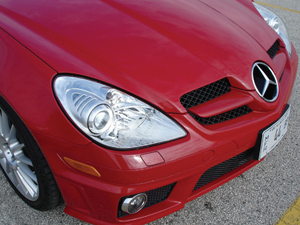 The basic idea behind adaptive lighting is to turn and aim the headlights like a pair of eyeballs so the light is projected where the driver really needs it. Lexus has been using such an adaptive headlight system since 2004 on the LS 430. You’ll even find it on new cars such as the 2010 Nissan Altima.
The basic idea behind adaptive lighting is to turn and aim the headlights like a pair of eyeballs so the light is projected where the driver really needs it. Lexus has been using such an adaptive headlight system since 2004 on the LS 430. You’ll even find it on new cars such as the 2010 Nissan Altima.
On the 2008 BMW 5 and 7 Series, for example, digital inputs from the steering angle sensor, vehicle speed sensor and yaw sensor are used to steer the headlights from side to side as the vehicle turns. When turning left, the left headlight will pivot up to 15 degrees toward the left, and the right headlight up to 7 degrees toward the left, to illuminate the road ahead. The right headlight doesn’t turn in as much as the left one so it will still provide good illumination of the road ahead. This creates a walleye effect with the headlights, but BMW says it increases forward visibility when driving on a winding road from 53 meters (174 feet) with conventional straight-ahead halogen headlights, to 89 meters (292 feet) with its adaptive directional bi-Xenon headlights. The added range in visibility could easily make the difference between avoiding a deer in the highway or hitting it.
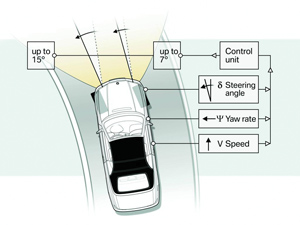 There’s already a technical service bulletin out on the new BMW adaptive headlight system (SI B 63 07 08) that covers a problem with the lights not always following the steering input. The cause of the intermittent headlight aiming issue is a software glitch, and is cured by reflashing the PCM with an updated code (which, of course, requires a BMW factory scan tool or J-2534 pass-thru tool).
There’s already a technical service bulletin out on the new BMW adaptive headlight system (SI B 63 07 08) that covers a problem with the lights not always following the steering input. The cause of the intermittent headlight aiming issue is a software glitch, and is cured by reflashing the PCM with an updated code (which, of course, requires a BMW factory scan tool or J-2534 pass-thru tool).
Some adaptive headlight systems also compensate for hills and dips in the road by aiming the headlights lower or higher. On the 2007 Mercedes C350, for example, there’s a suspension height sensor on the rear axle that the adaptive headlight system uses to raise or lower the aiming of the headlights. If you load the vehicle down with luggage or passengers, the sensor detects the change in ride height so the aiming of the headlights can self-adjust to maintain maximum range and visibility. This also reduces glare in the eyes of oncoming motorists.
Night Vision
Another problem with conventional headlights, even adaptive ones, is that visible light travels only so far. Halogen lights are brighter and whiter than conventional tungsten filament, and improve nighttime visibility. Likewise, xenon and other high intensity discharge (HID) headlamp systems are brighter and whiter to extend range and visibility even more.
The typical xenon headlamp produces about 3,000 lumens of light compared to 1,400 for a halogen bulb. The color of the light produced by a xenon bulb is even closer to daylight, though to oncoming drivers, HID headlights typically have a bluish appearance. The higher the temperature rating of the HID bulb, the bluer it appears.
Rain, snow and fog can all severely restrict nighttime visibility by causing light to reflect back into the eyes of the driver. What’s more, objects that do not reflect light well, such as pedestrians wearing dark clothing, black or dark gray animals, etc., may be difficult to see even with good lighting, especially at higher speeds where more reaction time may be needed to avoid a collision. That’s where night vision capabilities come in handy.
According to most accident statistics, more than twice as many accidents and fatalities occur after dark rather than during daylight hours. Part of this is due to sleepy or impaired drivers, but part is also due to the reduced visibility that occurs after the sun goes down. Any technology that improves night driving visibility, therefore, should improve driving safety.
Night vision goggles have been used by the military for many years to gain the advantage when fighting in the dark. The technology used in first-generation night vision goggles relied on light amplification electronics to make dimly lit terrain appear much brighter. It’s similar to night vision in many nocturnal animals. There’s a special reflective layer on the back of the retina inside their eyeballs that bounces light back through the receptor cells to amplify low-light vision.
The limitation with light amplification technology (electronic or biological) is that it requires at least some minimal level of light to see well. Thermal imaging that sees heat (infrared light) has no such limitations. It can see objects in total darkness. Anything that gives off heat (people, animals, trees, cars, etc.) can be easily seen at night with a Far Infrared (FIR) thermal camera.
What’s more, the view is affected less by fog and rain than technologies that rely on reflected light for night vision. FIR night vision cameras can see up to 400 meters (more than 1,300 feet) down the road, which is well beyond the range of most headlight systems, even high wattage off-road lighting systems. FIR night vision systems are often called “passive” night vision because they do not require any additional lighting to illuminate objects.
The main drawback with FIR night vision technology is that it’s expensive. Such systems typically add up to $2,200 or more to the cost of the options on a new vehicle. A domestic vehicle manufacturer (Cadillac) was actually the first to offer night vision as a factory option back in 2000. The Raytheon system had a grille-mounted camera and a head-up display that produced a ghostly black and white image.
GM dropped the option in 2004 due to poor sales. But in 2004, Honda reintroduced the night vision concept on the Legend with a system called Intelligent Night Vision that added an audible and visual warning when it detected a pedestrian in the road ahead.
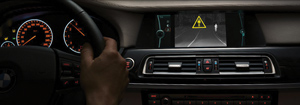 Some additional import applications with FIR passive night vision systems include 2005 BMW
Some additional import applications with FIR passive night vision systems include 2005 BMW
7 Series and 2006 BMW 5 Series. The night vision images produced by the BMW system are viewed on the navigation screen.
A less expensive alternative to FIR night vision technology is that which uses a Near Infrared (NIR) camera. NIR systems are sometimes called “active” night vision systems because they rely on infrared illumination from the headlights. Next-generation NIR systems may use low-power infrared lasers for illumination. NIR night vision systems don’t have the range of FIR night vision systems (150 to 200 meters versus 400 meters for FIR), but they cost only a few hundred dollars versus several thousand dollars. They also tend to produce more realistic image displays that reveal details not detected by FIR systems (such as the edges of the road and the lines painted on the highway).
Some import vehicles with optional active night vision systems include 2002-’07 Lexus LX 470, 2002 Toyota Land Cruiser, 2005 Mercedes S-Class, 2006 Mercedes CL-Class and 2009 Mercedes E-Class.
While searching AllData, I found a TSB (SI B 66 04 06) that covers night vision malfunctions on the 2007 BMW 750i. Faults include a distorted, unclear or inverted display image, or no image at all, with fault codes A78F (video signal to the NVE system disturbed) and/or A74E (LIN bus fault to the night vision camera). If the problem is not a wiring fault and the camera has to be replaced, it comes with an unlock VIN number on a CD that has to be programmed into the vehicle’s computer (which requires the factory scan tool).
Backup Cameras
Another area where technology is improving driving safety is when backing up. It’s very difficult to see what’s directly behind a large SUV. If an object isn’t visible in the rearview mirrors and can’t be seen by glancing over the shoulder, it’s assumed to not be there. It’s sad how many kids and pets are accidentally run over each year by vehicles being backed out of driveways.
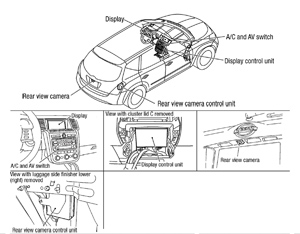 The backup camera is a great application of digital imagery. The introduction of cheap digital cameras has brought the price of this technology down to a couple hundred dollars or less, making it an affordable option on a much wider range of vehicles. You can even buy wireless aftermarket backup camera systems that mount on the back of any vehicle and are simple to install for less than $150!
The backup camera is a great application of digital imagery. The introduction of cheap digital cameras has brought the price of this technology down to a couple hundred dollars or less, making it an affordable option on a much wider range of vehicles. You can even buy wireless aftermarket backup camera systems that mount on the back of any vehicle and are simple to install for less than $150!
Most backup cameras use an inexpensive “CCD” (Charge Coupled Device) optical sensor similar to the ones used in cell phones and web cams to produce an analog image signal. More expensive and sophisticated “CMOS” (Complementary Metal Oxide Semiconductor) optical sensors that produce a digital output are replacing many CCD chips as the technology moves forward. But for now, CCD cameras are still more common because of their lower price and compact size.
On most factory backup systems, the backup camera switches to the display mode when the transmission is placed in reverse. The image is usually displayed on the navigation screen. The same camera may also be used with a Parking Assist system to help maneuver the vehicle into a tight spot when parallel parking.
Backup camera systems are relatively simple, but like any other technology can fail for a variety of reasons (camera lens obstructed, bad camera, wiring fault, display fault, bad display unit or bad control unit). Diagnosis usually requires a factory scan tool. If the backup camera has to be replaced, it may require an adjustment procedure using the scan tool – especially if it is part of a Parking Assist system.
Blind Spot Detection
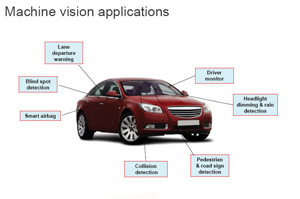 The 2008 Volvo C30 has a small camera in both outside rearview mirrors that are used to detect vehicles in the right and left blind spots. A visible warning is displayed when another vehicle is in either blind spot, and an audible warning sounds if the driver starts to change lanes without noticing the other vehicle.
The 2008 Volvo C30 has a small camera in both outside rearview mirrors that are used to detect vehicles in the right and left blind spots. A visible warning is displayed when another vehicle is in either blind spot, and an audible warning sounds if the driver starts to change lanes without noticing the other vehicle.
Blind spot detection is expected to be offered on a growing number of vehicles as vehicle manufacturers increase their emphasis on safety. In 2008, federal legislation was signed into law that will eventually set rearward visibility standards. The automakers have up to seven years to comply, but many are moving forward with backup cameras and rearview blind spot detection cameras ahead of the deadline.
The Big Picture
The big picture is that cars are getting smarter as drivers are getting more distracted while driving. As the cost of technology comes down, adding new safety features such as adaptive headlights, night vision, backup cameras, blind spot detection and other systems becomes more affordable and practical.
Display-based safety systems where the driver makes decisions based on what he can see will increasingly be replaced with automated systems that make decisions for the driver. We’ve seen it already with antilock brakes and stability control, as well as collision avoidance braking. Lane departure warning systems that sound an alarm if a vehicle starts to drift may soon be replaced with ones that actually correct the steering if the driver fails to respond. An in-car camera may also be used to monitor the alertness of the driver, and to reduce speed or even stop the vehicle if the driver appears to be impaired or has fallen asleep.
Vehicles that can drive themselves using a variety of technologies have already been developed, so the day when you can walk into a new car dealership and drive out in a car that drives itself may not be that many years in the future.
